One of the biggest differences between low and high-quality sushi rolls are the texture and consistency of the rice. Low-quality sushi rolls typically fall apart because the rice isn’t sticky enough to hold the roll together, while high-quality rolls remain firm and solid due to extra-sticky sushi rice.
So, how do you make sticky sushi rice?
To make sushi rice sticky, you’ll need to start with short-grain rice, as it releases more starch that holds the grains together. Additionally, you’ll need to use a combination of steam cooking along with rice vinegar to achieve the stickiest sushi rice possible.


Making the ultimate sticky sushi rice may seem complicated, but it’s actually quite simple. You just have to follow the instructions closely, and not skip a single step! Below, I’ll show you my step-by-step process for making some of the stickiest, best-tasting sushi rice. Let’s roll!
What Makes Sushi Rice Sticky?
Before I get into my step-by-step guide for making extra-sticky sushi rice, I figured that I may as well explain exactly what makes sushi rice “sticky” so that you better understand the steps below.
In short, it all has to do with starch. Starch is contained in all rice but is higher in certain types of rice. The more starches that the rice releases during cooking, the stickier it will be. Once you have a high-starch rice variety, the key to making sticky rice is to use a cooking process that causes the rice to release as much starch as possible, causing it all to clump together.
Below, I’ll show you just how to do that.
How To Make Sushi Rice Sticky: Step-By-Step
If you follow these step-by-step instructions, I guarantee that you’ll have some of the best restaurant-grade sticky sushi rice you’ve ever had. You can then use it to make your own sushi rolls or neat sashimi-style sushi.
Step 1: Start With High-Quality Short-Grain Rice
As I mentioned, the key to sticky rice is to use the right type of rice. Short-grain white rice has higher starch content than any other type of rice on the market. Medium and long-grain white rice don’t release as much starch as short-grain rice, so they aren’t recommended. You should be able to find short-grain white sushi rice at your local Asian supermarket or grocery store.
Step 2: Soak The Rice (The Longer The Better)
This is an important step that most people neglect because they’re in a rush. While it is possible to make moderately sticky rice without pre-soaking the rice, you’ll want to soak the rice in filtered water for between 4 and 10 hours for maximum starch release.
The longer you soak the rice, the more the starches in the rice will begin to soften, break down, and be released. This means that once the cooking process starts, the rice will achieve maximum starchiness, allowing it to stick together perfectly.
If you’re in a rush, try to soak the rice for around 4 hours before you plan on cooking it. If possible, though, soak it overnight for a solid 8 to 10 hours.
Step 3: Steam The Rice
To make sticky rice, it’s essential that you steam the rice. Do NOT boil the rice, as this will wash away the starchy coating on the rice, preventing it from sticking together. To make the best sushi rice, I always recommend that people cook their rice with a rice cooker. These simple devices allow you to place water at the bottom, which is then evaporated into a basket where your rice is resting.
Step 4: Add Rice Vinegar
Once the rice is finished steaming in the rice cooker, you’ll want to add around 1.5 tablespoons of rice vinegar per 1 cup of rice. The rice vinegar is primarily used to flavor the sushi rice, but it also helps the rice clump together and become even stickier.
How Long Is Sushi Rice Good For?
Sushi rice can be kept at room temperature for around 5 hours after it’s finished cooking. It’s best to use it during this time period, as it can start to lose its freshness afterward. If you have leftovers, then you can store your sushi rice in an airtight container for up to 24 hours in the refrigerator.
However, the longer it sits in the fridge, the less sticky it will become. If it sits for more than 24 hours, your best bet is to use it for a soup or a hibachi-style dish since it will have lost most of its stickiness.